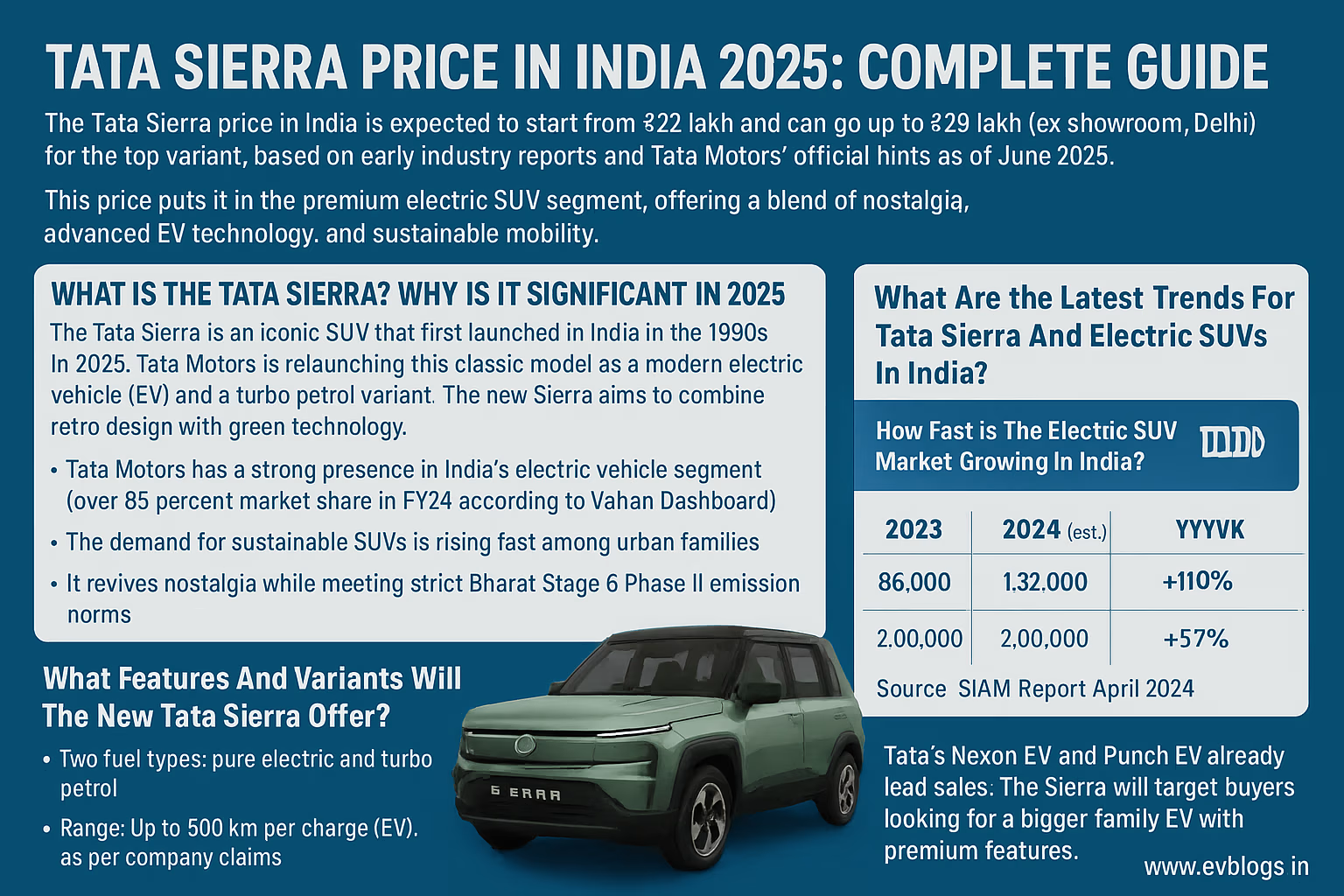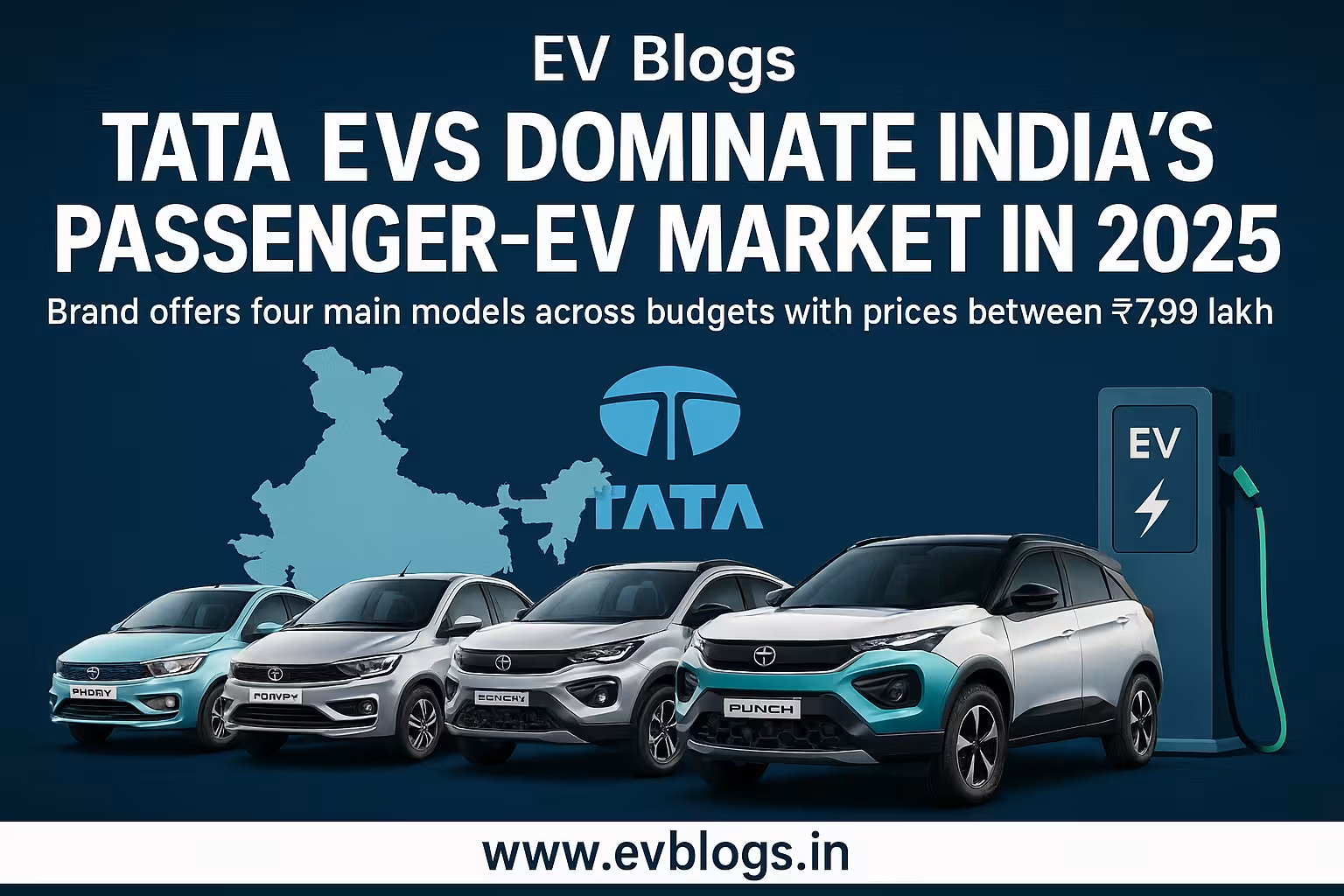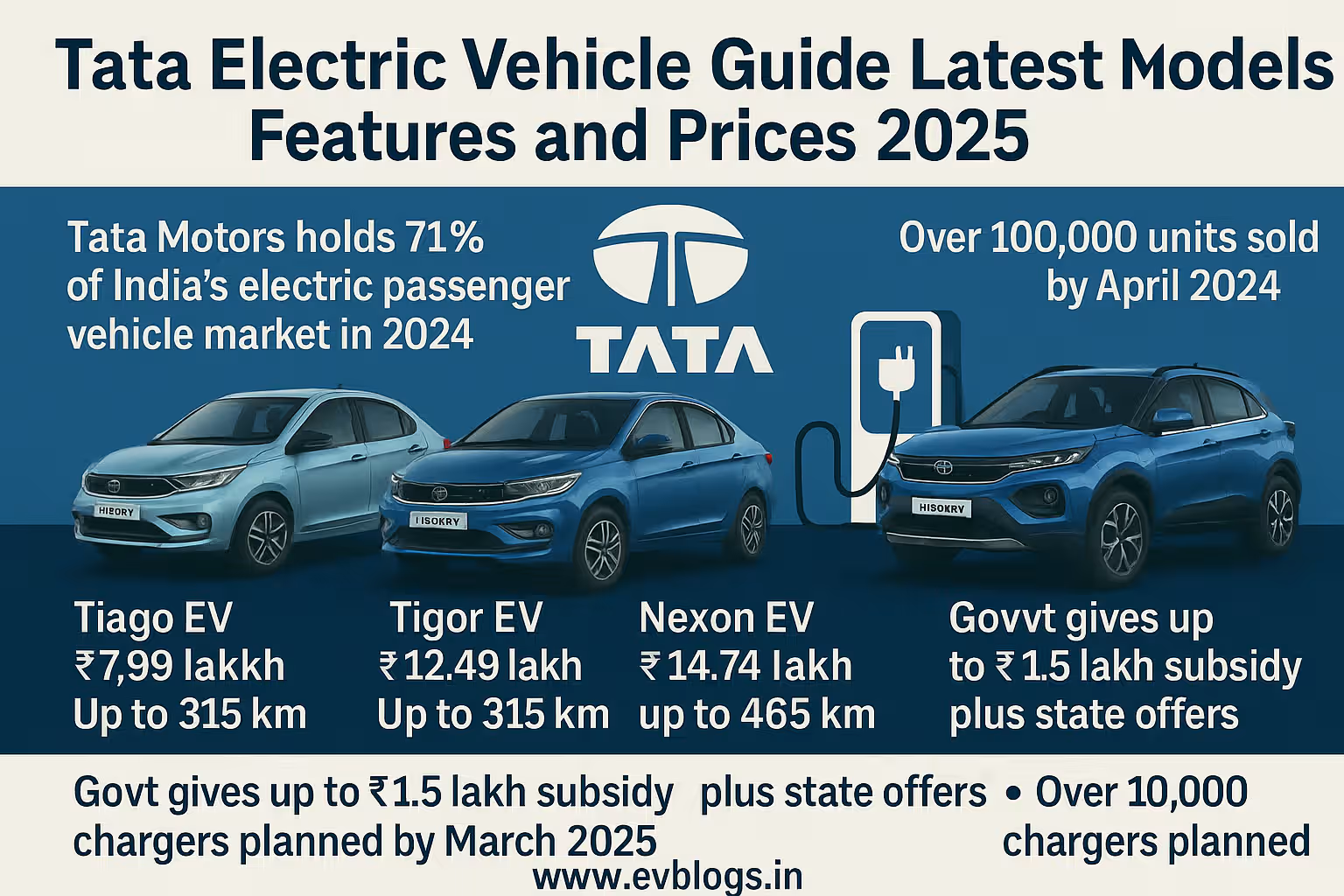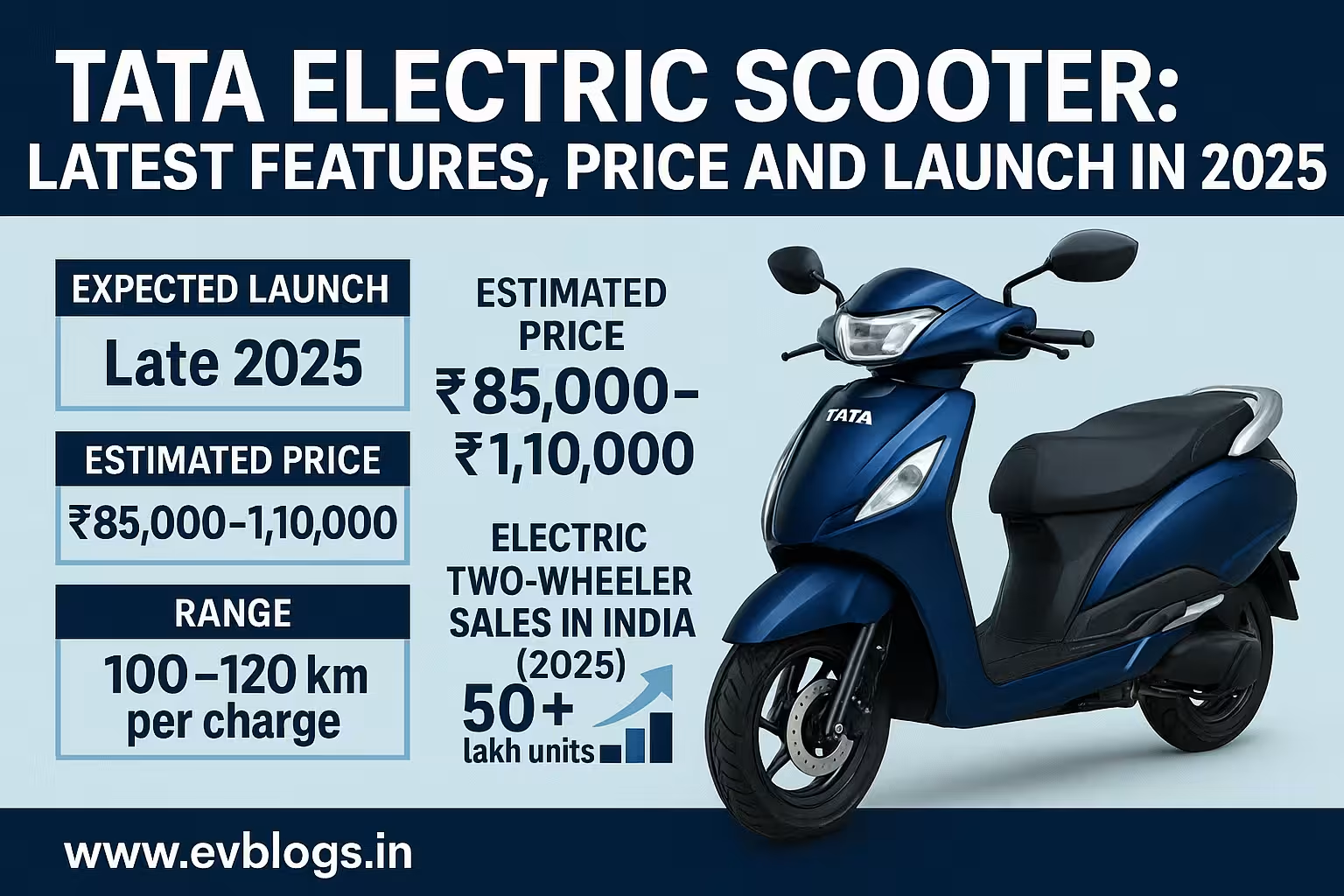Hedhvick Hirav
Hedhvick Hirav is a dedicated EV researcher and editor with over 4 years of experience in India’s growing electric vehicle ecosystem. Their contributions have been recognized in leading sustainability publications and automotive journals.
Summarize & analyze this article with
Choose an AI assistant and open this article directly:
Tip: if the AI doesn’t fetch the page automatically, paste the article URL manually.
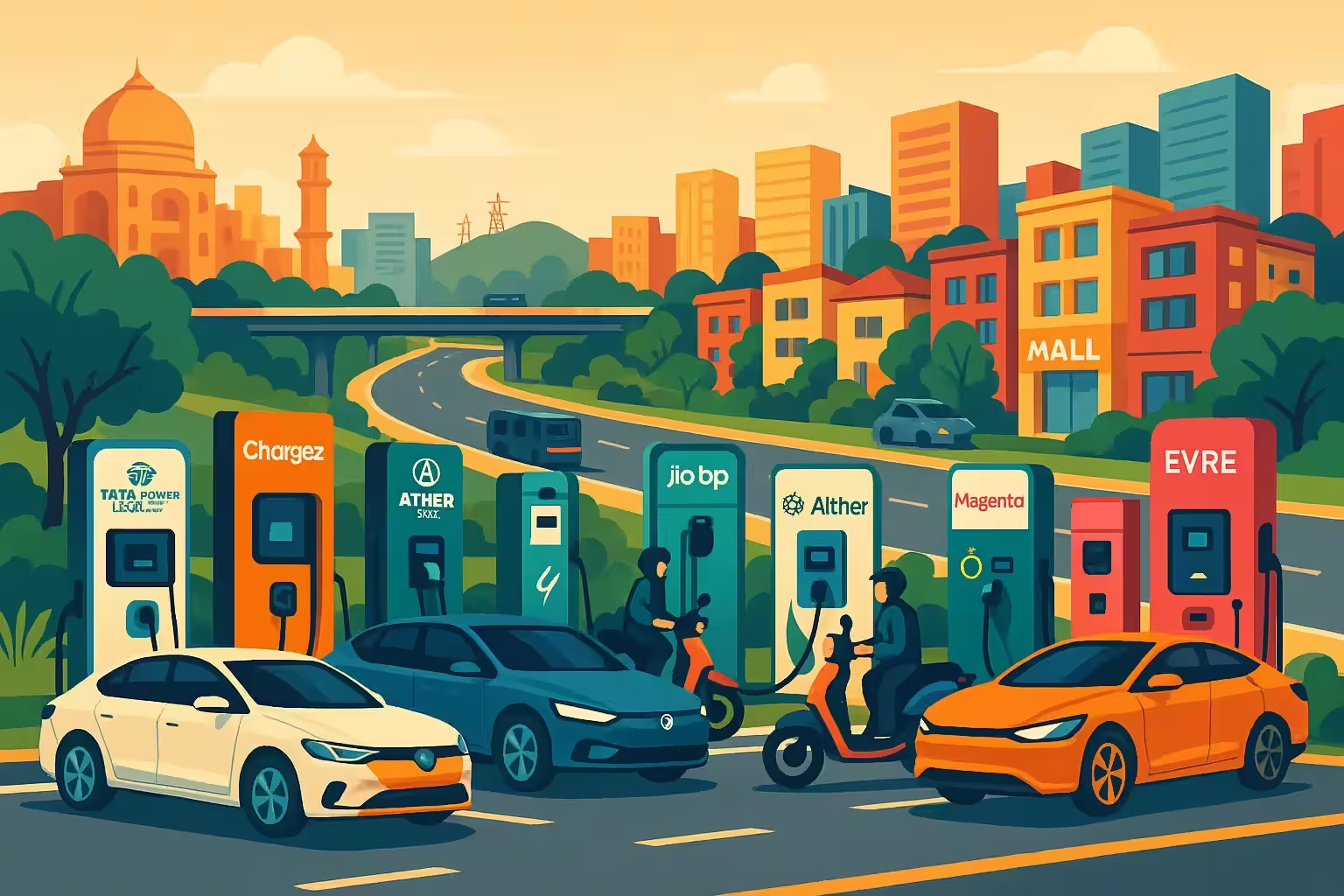
Is Tata electric vehicle Share Price a buy? All You Need to Know in 2025
Electric vehicle (EV) is blasting its way in India and Tata Motors is on the forefront. If you are wondering whether to invest in the electric vehicle (EV) shares of Tata in 2025, then you are not alone. With Tata EV, another question on the minds of Indian investors is whether it is a sound investment in the future. Read this guide to make your decision with the most recent facts, exact figures and expert opinions.
What is Tata Electric Vehicle Share Price in 2025?
Tata Motors is now no longer a conventional automaker company. By 2025, Tata is the leading EV brand in India with the Tata Nexon EV, Tiago EV and Tigor EV leading the streets. The share price of the company is considerably affected by its electric vehicle sector.
Here is the reason Tata EV stocks are so appealing:
- In FY 202425, Tata Motors sold an all-time high 94,000 EVs, cornering more than 70 per cent of the electric-car market in the country.
- In the year 2025, the revenues generated by the company on sleeves on EVs have grown by 73% year-on-year making it the fastest-growing segment within the Tata Motors.
- The tie-up that Tata has with Jaguar Land Rover (JLR) has resulted into new EVs and upgrades in technology.
- Strength in government policies including the FAME II subsidy and new state level EV incentives continues to strengthen the demand.
- The growth of Tata Power charging network provides additional benefits, as the vehicles of the brand will be more convenient to use daily.
Did You Know? JC20161124
Tata Motors will roll out 10 new EV models till 2026 and have 25 per cent of overall sales in 2027 through electric vehicles.
Tata Motors EV Share Price Performance (2022-2025)
| Year | Share Price Start | Share Price End | % Growth | Major Catalysts |
|---|---|---|---|---|
| 2022 | 400 | 620 | 55% | Nexon EV sales boom |
| 2023 | 620 | 775 | 25% | Tiago EV is launched, FAME II boosts |
| 2024 | 775 | 935 | 20.6% | New models, incentives of the govt. 54 percent |
| 2025 (Between June) | 775 | 935 | 20.6% | EV infra growth, high demand |
Trend line dates are until June.
Tata Motors shares will be more inclined toward EVs in their portfolio as compared to most stocks within the auto sector in India during the past 3 years.
The price of the shares is sensitive to changes in EV, quarterly sales and changes in government policy.
Frequently Asked Questions: What is the present market share of Tata Motors in the electric vehicles (EV) category of India?
In 2025, Tata Motors commands an overwhelming market share in electric cars in India of more than 70 per cent, leaving its closest rivals, MG, Mahindra and BYD behind.
What is the comparison that Tata electric vehicle business gets to its competitors in India?
However, it will be an idea to compare how Tata EV business fares to that of other stakeholders. This is how the Tata performs against its 10 main rivals in the Indian EV market in 2025.
Facts about Tata Competition with Top 10 Electric Car producers in India (2025)
| Company | Market Share 205 (%) | Models 2025 | FY25 EV Sales | Avg. Price (Indian Rupee) | Profit Margin | R&D Spending ( Indian Rupee Cr) | Charging Points |
|---|---|---|---|---|---|---|---|
| Tata motors | 70 | 5 | 94,000 | 9-19 lakhs | 8.2% | 1,850 | 5,700+ |
| MG Motor | 11 | 2 | 14,500 | 24-28 lakhs | 6.4 | 520 | 1,200 |
| Mahindra | 7 | 2 | 9,000 | 15-22lakhs | 6.8% | 630 | 800 |
| Hyundai | 8 | 4 | 25,200 | 24-46 lakhs | 7.9 | 900 | 1,100 |
| BYD | 2.5 | 2 | 3,100 | 30-39 lakhs | 7.2 | 400 | 600 |
| Kia | 1.2 | 1 | 1,500 | 23 lakhs | 5.9 | 300 | 500 |
| Toyota | 1.0 | 1 | 1,200 | 40 lakhs | 5.5 | 200 | 200 |
| Citroen | 0.8 | 1 | 900 | 12lakhs | 5.1% | 150 | 150 |
| Honda | 0.5 | 1 | 650 | 18 lakhs | 4.8 | 100 | 80 |
| Renault | 0.5 | 1 | 600 | 11 Lakhs | 4.4 | 90 | 60 |
Comparison Top Insights
- Tata has the most extensive line-up of EVs in the mass market, spread across budgets.
- It has the biggest charging network in India (and a partnership with Tata Power) comprising 5,700+ public points.
- Tata has a triple higher R&D expenditure compared to most of its competitors resulting in an acceleration in the pace of innovation.
- Tata EVs are also the cheapest, which makes them reach a wider number of people in India.
- Mahindra and MG Motor are the primary rivals, but they have much less sales and networks.
- Hyundai and BYD pursue high-end electric vehicles which restricts their presence in India.
- Japanese brands (Toyota, Honda and Renault) are experimenting in Indian EVs are at their initial phase.
Expert Insight
ICICI Securities says that in 2025, Tata Motors is the natural choice of retail EV investors due to its aggressive EV scheme and benefit of cost leadership.
People Also Ask: Which companies are the biggest rivals of Tata Motors on the Indian electric car market?
Mahindra and MG Motor are the two principal competitors of Tata in 2025; however, Tata is outselling them more than 6 times.
Why is the Tata Electric Vehicle Share catching the attraction of investors in 2025?
You could be asking why Tata EV shares are attracting so much attention. Why Investors are excited in 2025:
- Massive Opportunity: The Indian electric vehicle industry is projected to expand by 38 percent CAGR by 2030 and Tata will be the largest beneficiary of this trend.
- Heavy Government Support: Prius subsidies, of the GST is just 5 percent on EVs, and also ceiling of the loans through green finance schemes.
- First-mover advantages: Tata introduced EVs in India first as compared to the competitors and thus has high brand trust.
- Robust Ecosystem: Single-stop ecosystem of Tata (cars, batteries, charging and software) provides it with a distinct advantage.
- Profitability: Tata’s EV arm became profitable at the end of the year 2024 a unique move in the Indian automobile industry.
What Are analysts and experts saying?
- Tata Motors has a Buy or Add recommendation by most leading Indian brokerages (such as Motilal Oswal, Kotak and HDFC Securities) as they feel that the stock has a strong growth in EV.
- The holdings by foreign investors are also on the ascendancy so the proportion of FII holding has also increased to 18.6 in March 2025.
- Exportation of EVs to the Middle East and Africa by Tata began in 2025 to enable the company tap into new growth markets.
- Its battery-joint venture with Agratas (Tata Group) should save it 18 percent by 2026.
Did You Know?
The Tata Tiago EV is the latest entry in the list of the cheapest electric cars in India at 7.99 lakh (ex-showroom in 2025).
Frequently Asked Questions: Is Tata Motors profitable in its electric vehicle business?
Yes, Tata EV business unit crossed the profit barrier in Q3 2025, due to high sales and expense management.
How Can You Rate Tata Electric Vehicle Share To Invest In Long-term?
Before investing in it, it is wise to see whether the shares of its EV suit your financial objectives or not. To judge them evaluate the following:
Financial Performance
- The revenue EVs: In 2025, it is expected to mature 73% in revenue.
- Profit margin on EV: 8.2 percent, which is more than that of the total auto division.
- Debt-equity ratio: We would rise to 1.1 (2025) as opposed to the current 1.9 (2022).
Growth Prospects
- Same can be said about the EVs, as the company plans to introduce 10 new EVs by 2026.
- A powerful pipeline of both low-cost and luxury EVs.
- The spread in new markets of exportation
Track Record in a Management Career
- The leadership of Tata Motors has achieved its EV targets in advance.
- CEO Shailesh Chandra is an acknowledged industry leader in the EV industry in Asia.
Market Conditions
- The prize in India is sizeable since EV penetration is only 2.5% in 2025 and has much potential to be expanded.
- Increase in fuel prices and urbanization, and fuel pollution regulation contribute to the EV demand.
Risk Factors
- Intense rivalry by international car-manufacturers entering India.
- The fluctuation in raw material prices applied by batteries
- The need to depend on government incentives in order to enjoy mass adoption.
Tata EV Shares -Checklist to evaluate
- Do you like medium term volatility?
- Do you have a faith in the Indian EV future?
- Do you want to grow within 3-5 years not immediately turn huge profits?
- Are you able to overcome regulatory risk (changes in policy, subsidy revisions)?
What risks exist in investing in years in Tata Motors EV shares?
Powerful competitors, battery prices and fluctuations in government policy regarding subsidies on EV are the main risks.
What is the Proper Time to purchase Tata Electric Vehicle Shares?
It is great to make your investment at a good time but you do not need to be held back by the desire of hitting the bottom. That is how you can determine the best time:
Watch Q4 Results
- Tata reports the results quarterly; compare with high sales of EVs.
- The first and the third quarters are high sales quarters in most cases.
Subscribe to Policy Announcements
- Government incentives can increase the share price because of new incentives offered by the government.
- Demand may also be increased through state-level policies (such as the ones in Delhi, Maharashtra, Karnataka).
Competitor Action Monitor
- New launches of MG, Mahindra, or Hyundai can raise the market share of Tata.
- Wait for the world brands such as Tesla or BYD before entering the mass market.
Keep in to worse, as the trend develops.
- This can be analyzed by using moving averages (50-day, 200-day).
- When markets correct, look out on dips as on-going buying opportunities.
Till Jun 2025 Share Price Movement (Tata motors)
| Month | Opening Price (₹) | Closing Price (₹) | Major Trigger |
|---|---|---|---|
| Jan 2025 | 775 | 792 | FY24 earnings, EV sales skyrocket |
| Feb 2025 | 792 | 808 | The launch of a new variant of Tiago EV |
| Mar 2025 | 808 | 835 | Chief origin |
| Apr 2025 | 835 | 870 | FAME II subsidies extended by Govt |
| May 2025 | 870 | 910 | Battery JV news |
| Jun 2025 | 910 | 935 | Partnership for charging |
The vast majority of analysts suggest that it is best to buy on the dips, particularly, following quarterly corrections.
Long-term Systematic Investment Plan may help eliminate the volatility.
Expert Insight
Long-term investors see any downturn as an occasion to buy shares of Tata since the company has a strong EV strategy and position, which it continues to pursue aggressively. Kotak AMC (2025) Nilesh Shah
People also ask: Which is better to invest in Tata Motors share one lump sum or SIP?
SIP solutions and strategies will not only allow you to average out your price of purchase but will offer you flexibility from volatile markets and hence recommended by most retail investors.
What Do Real Indian Investors Say about Tata Electric Vehicle Shares? Case Studies & Stories
Real-world insights, in this case concerning real investors, can assist you in associating yourself with the living experience of Tata EV shares.
Investor Story 1: Ramesh, 38, Bengaluru
- It had 2 lakh of its money invested in Tata Motors stocks at the end of 2022.
- The choice of Tata lay in the evident EV leadership and low-cost car launches.
- This investment is growing by June 2025 to 5.9 lakhs nearly 200% upward.
- “I commute on Gurugram everyday where I use Nexon EV. So I have observed the developments of Tata closely. I will continue to hold the stock possibly 5 years or more.”
Investor Story 2: Priya, 29, Mumbai
- Those are 100x SIPs in Tata Motors of 5000 a month, starting January of 2023.
- He is a fan of the investment direction of this company in regards to clean mobility coupled with good managements.
- Now intends to change her petrol hatchback to a Tata Tiago EV by 2025.
- “As an investor and customer, Tata is very reassuring because of its stable quarterly collections and new launches.”
Investor Story 3: Amit, 45, Pune
- Guy invested in Tata shares in response to the advertisements of the charging station expansions in his city.
- “The ease of use reality is true Nowadays, Tata networks all over with EV and the popularity of the brand is going to increase.”
What is in the Social Media and Forums?
Majority of retail investors in forums and twitters like Moneycontrol, Quora and Twitter are optimistic about the EV future of Tata.
There are some worries on high valuation, but a deep sense that this stock will grow in the long-run.
Securities gurus advise periodic examination of your equity positions, but certainly not less than 3 to 5 years of ownership.
Frequently Asked Questions: Is it a good stock with Tata Motors shares to make a beginner in the stock market investing?
Tata Motors is a known, and fundamentally strong company; it is also an apt company to invest in considering its long-term perspective.
What are the Tata EV business and India, EV policies and Vision 2030?
One of the largest forces that propelled EV acceptance in India is Govt policy. These policies are closely related to the strategy of Tata.
There are however, Key Policy Drivers anticipated in the year 2025.
- FAME II Subsidy: The timeframe extended and up to 2026, provides a discount of up to 1.5 lakh on electric vehicular cars.
- State Incentives: Maharashtra, Delhi and Karnataka has extra on-road discount and lower registration.
- GST Advantage: Just 5 percent GST on EVs compared to 28 percent of the GST on petrol / diesel cars.
- Green Number plates: EVs are given special treatment in terms of being given free toll and parking services in certain cities.
- Production Linked Incentives and Battery Incentives: The battery units of Tata can enjoy the benefits of Production Linked Incentives, which will cut cost.
The reaction of Tata to policy support
- Tata has established local production of batteries thus limiting imports.
- Hybrid cars are currently being sold in nearly all states of India and finding inexpensive financing is provided.
- Partnerships with the state governments to roll out charging infrastructure.
Electric vehicles Vision 2030 - India
- Goal: 30 percent of the entire vehicles to be electric by 2030.
- Tata is hoping that by 2027 at least a quarter of its car sales will be electric.
- The local R&D facility also assists Tata to conform to government regulations of local production through Make in India.
- The company is incurring investments in recycling and sustainable battery disposal, in new environment norms.
Did You Know?
Tata recently announced battery recycling program in collaboration with Attero to recycle more than 10000 EV batteries till 2026.
People Also Ask: What effects do the government policies have on the EV business of Tata Motors?
Policies such as FAME II lower the cost of Tata EVs, which increases the demand and the share price directly.
What to be Cautious Within the Event of Investing In Tata Electric Car Stocks?
There are dangers even to great stocks These are the points you should make note of before investing in Tata EV shares:
Valuation Risk
- In June, 2025 Tata shares are sold at a price earnings (P/E) ratio of 33 that is above the 5 year average.
- High valuation means that short term corrections may be evident when growth is not in line with the expectations.
Competition Risk
- International leaders such as BYD, Tesla are paying more attention to India.
- New attractions in Mahindra, MG, and Hyundai may cannibalize the market of Tata.
The prices of battery raw materials
- A variable of lithium, cobalt and nickel prices can affect the margins.
- This risk can be diminished by 2026 by the local battery plant of Tata (Agratas).
Policy Dependence
- There is a danger of over dependence on subsidies in the event that the government support becomes scarse.
- Tata entering into low-priced EVs is an act that is a bet against subsidy reduction.
Execution Risk
- Poor growth can be attained when new EV releases are delayed or expansion in the charging network diminishes.
- It is also significant to observe the quarterly progress and management letters.
Risk Management Risk management checklist
- Never put more than 10, maybe even 15 percent of the maintenance on a single stock.
- Review you investment quarterly
- Be notified of Tata investor presentations and earnings calls.
People Also Ask: What presents the greatest threat to Tata Motors EV development?
The primary threat is intensive competition and possible decrease in the government subsidies.
Verdict: Tata Electric Vehicle Stock Price-To Invest or Not in 2025?
When you read every piece of information and see all the figures and the very experiences of real investors, the answer to the question would be simply the following way:
- Tata Motors is at the forefront of electric vehicles in India that boasts of leading sales, products and ecosystem.
- India is the fastest-growing country in terms of EV adoption and the company stands to take advantage of its EV revolution and the government support.
- The EV business of Tata has turned profitable, has huge growth and solid management.
- All the risks can be mitigated when you invest in a 3 to 5 years narrative and do not place all of your funds on a single stock.
In case you are confident in the electric future of India, then Tata Motors is one of the best buy-ins to this expansion. Investors who are willing to play long-term games (i.e. 2025-2030) and have conducted necessary research beforehand, Tata Electric Vehicles shares are an intelligent choice.
FAQs: Tata Electric Vehicle Share Price Is Investing Right?
Q1. What does the future hold in Tata Electric Vehicle share in India?
The outlook is good with a projected growth of 30-40% in the EV category annualy and new launches till 2026.
Q2. Is it safe to buy shares in Tata Motors at present?
Although no stock can be kept as 100 percent safe, Tata is safer in the light of its leadership, diverse business and its financials.
Q3. Will Tata be able to hold its market share in the EVs when new entrants land?
The first mover advantage, the local research activity and extensive charging infrastructure provide Tata with a great competitive advantage.
Q4. I can purchase either short-term or long -term gains in Tata Motors shares.
Long-term investors who are able to sustain their investment depending on the market trends are the best candidate to purchase Tata Motors shares.
Decision making: Generate an Intelligent, Informed Choice
Tata Electric Vehicle stock is a unique growth stock with a big potential, a top management position and a positive real-life and environment impact in the rapidly developing Indian automobile industry. Betting on Tata Motors in 2025 is more than simply investing in a company: it is a wager over India clean mobility future. Be sure to do your own research, keep abreast, and invest towards the long-term. Tata is taking its first steps on the EVs-path and are you part of it?
Frequently Asked Questions (2025) on Structured Data (2025)
Q1. How much revenue will Tata Motors make in 2025 on electric vehicles?
In June 2025, about 24 percent of the revenue of Tata Motors passangers car business comprises EVs.
Q2. What would be the Tata Motors EV range in 2025 against Mahindra?
Tata has 5 EVs, with prices ranging over a wide spectrum whereas Mahindra has only 2 with most of them in the SUV range.
Q3. Are Tata EV Shares SIP suitable?
SIP can assist volatility management and work well in creating wealth in the long run with Tata shares.
Q4. Is Tata Motors dividend payable in 2025?
Yes, Tata Motors restarted its dividend distribution in 2025 as the result of the profitability increase.
Q5. Will Tata Motors enjoy the new battery policy of the government in 2025?
Yes, on the localised battery production, Tata is provided incentives, reducing the costs and increasing margins.
Still, have some questions or want to receive analysis updates? - Bookmark this guide. Investing is also about knowledge so use it to your favor.
If you have more questions or want updated analysis, bookmark this guide. Investing is all about knowledge—use it to your advantage!




